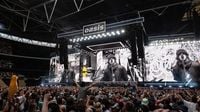Thousands of fans descended upon Edinburgh this weekend, as Oasis made their triumphant return to Scotland for the first time in 16 years. The legendary Mancunian rock band, fronted by the iconic Gallagher brothers, Liam and Noel, kicked off the first of three highly anticipated, sold-out shows at Murrayfield Stadium on Friday, August 8, 2025, with additional concerts scheduled for Saturday and Tuesday. For many, the event wasn’t just another gig—it was a full-blown cultural happening, rekindling the fervor of Britpop and the nostalgia of 1990s music in the heart of the Scottish capital.
The excitement in the city was palpable in the days leading up to the concerts. According to STV News, fans had been “counting down the days” since they managed to secure tickets, a feat in itself given the overwhelming demand. One attendee told the outlet, “It’s a dream come true. It’s going to be the greatest gig of our lives.” Four women who traveled from the North East, and who first saw Oasis at Loch Lomond nearly three decades ago, described their anticipation for the Edinburgh show as “absolutely buzzing, it’s going to be absolutely crazy.”
Oasis’s return to Scotland was part of their Oasis Live ’25 Tour, a global comeback after a 16-year hiatus that has reignited Britpop fever and sent fans into a frenzy. The band’s setlist, while kept under wraps for Murrayfield, has in recent shows featured classics like Wonderwall, Morning Glory, Talk Tonight, D’you Know What I Mean?, and Don’t Look Back in Anger. These are the anthems that launched the band to international stardom and, as The Times notes, continue to resonate with listeners of all ages, especially the younger generation discovering Oasis for the first time.
The scale of the tour is staggering. Analysis by Birmingham City University, cited by The Times, forecasts that the Oasis Live ’25 Tour will rake in at least £400 million in ticket sales and merchandise, averaging £9.7 million per show. This puts them ahead of other rock giants like U2 and Coldplay in terms of per-show earnings, and just a hair below Taylor Swift’s record-breaking Eras Tour, which averages £10.3 million per concert. The tour, though relatively short at 41 shows across 17 cities worldwide over five months, is expected to be one of the most lucrative in rock history.
Demand for tickets has been nothing short of extraordinary. About 1.5 million people managed to secure seats for the UK dates in Cardiff, Manchester, London, Edinburgh, and Dublin. Yet, more than 14 million fans from 158 countries tried to buy tickets, meaning only one in ten hopefuls were successful. This echoes the band’s legendary Knebworth gigs in 1996, where 2.5 million people applied for tickets to see Oasis play to 250,000 fans over two nights. For many, seeing Oasis reunite is, as The Times puts it, “a pilgrimage – and the opportunity to see Oasis reunite after they separated is priceless.”
Ticket prices reflected the scale and exclusivity of the event. Seats ranged from £73 to £205, with standing tickets at £150 and premium packages at Wembley reaching up to £506. By comparison, a ticket to the band’s 1995 tour was a mere £14. The financial windfall isn’t limited to the band, either. Liam and Noel Gallagher are each estimated to earn £50 million from the tour, with the possibility of even more through a potential film deal with Netflix or Amazon Prime—unsurprising given the success of the 2016 documentary Oasis: Supersonic.
Local economies have also felt the Oasis effect. According to Mastercard analysis, Manchester nightlife spending soared by 126% during the band’s shows, while Cardiff venues experienced a 56% boost, as reported by The Times. Fans are expected to spend an average of £766.20 each on tickets, travel, accommodation, memorabilia, and food—more than 11 times the average UK night out. Across the UK leg alone, this adds up to a projected £1.06 billion in total spending, surpassing even the economic impact of Taylor Swift’s Eras Tour in Britain.
Merchandise sales have been equally robust. Six official Oasis stores opened temporarily in each UK tour city, offering everything from gold and black tote bags (£20) to the now-iconic band logo bucket hat (£40) and Adidas coach jackets (£100). For some, fandom goes even further. Courtney-Jade Baker, a 26-year-old security consultant from east Bristol, got tattoos of the Gallagher brothers’ faces on her legs, spending £700 on the artwork and £300 on tickets. “I started listening to Oasis when I was nine after my step-dad introduced them to me,” Baker told The Times. “They were my gateway into Britpop.”
The ripple effect of the reunion has been felt beyond concert halls. Radio stations ramped up Oasis airplay, peaking at 727 plays on the tour’s opening day, with Wonderwall topping the charts as the most played song of 2025. The band has maintained at least three songs in the top 100 official charts, reaching number 17 with Don’t Look Back in Anger. Online, daily Spotify streams in the UK have surged by 197%, and globally by 116%, much of it driven by Gen Z listeners. According to The Times, these younger fans are among the most excited by the band’s reunion—proof that Oasis’s appeal spans generations.
To accommodate the deluge of concert-goers, ScotRail announced several extra train services to and from Edinburgh, increasing capacity to ensure no one was left stranded before or after the shows. The concerts also coincided with the bustling Edinburgh Fringe Festival, making for an especially vibrant atmosphere in the city. Ahead of the first gig, the band posted a simple message on X: “Edinburgh. Are you ready?” It racked up over 10,000 likes and drew a flood of enthusiastic replies from fans eager to witness the band’s return to the Scottish stage.
Following their Edinburgh stint, Oasis will take the Live ’25 Tour to Ireland, before heading to Canada, the United States, South Korea, Japan, Australia, and South America. The tour’s relatively short run—especially when compared to the likes of Guns N’ Roses’ 175-show reunion—only adds to the sense of urgency and excitement among fans worldwide.
So what is it about Oasis that keeps fans coming back, decade after decade? For many, it’s the band’s working-class roots and relatable lyrics. “Growing up with not a lot, listening to Oasis feels like home because they represent being able to make something out of nothing. They stand for everything I believe makes the world go round,” Baker explained to The Times. As the stadium lights dimmed and the first chords rang out across Murrayfield, it was clear that, for one weekend in Edinburgh, Oasis weren’t just back—they were bigger than ever.




